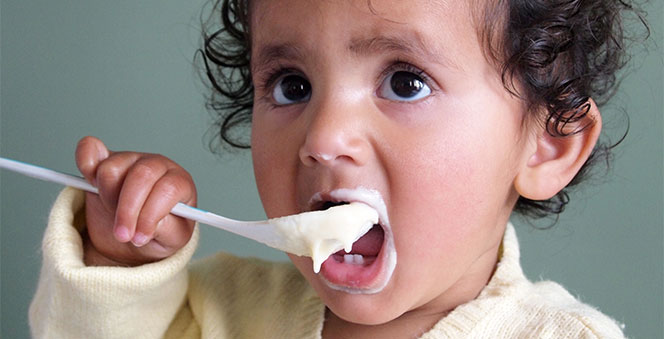When babies start teething and crawling this may be an ideal time to start baby on solids. This is often because she is prepared to chew and would be comfortable sitting in a high chair and holding her head steadily. Starting baby on solid Chart
The child’s digestive system also is more mature at this age, which suggests that the child can digest solids better. Complementary foods (aside from breast milk or infant formula) are added to a baby’s diet when her nutritional needs are no longer met by breast milk or formula. Before the age of 6 months, your baby gets all the nutrients she needs from your breastmilk or iron-fortified formula, so there’s really no need of giving solid food. It is recommended that you start your baby on something bland like rice cereal.
FOODS TO AVOID
Do not feed your baby cow’s milk before he/she may be a year old. This is often because cow’s milk may be a poor source of iron and doesn’t offer sufficient nutritional benefits. Avoid peanuts, fish, and eggs within the first year. Honey may be additionally a food best to be avoided until your baby is a year old. Spores of botulinus in honey can grow inside your baby’s intestines and release a toxin. There is no denying that breastmilk has innumerable benefits for newborns. Babies under 12 months aged are vulnerable to this.
STAGE ONE 6 MONTHS TO 7 MONTHS
WHAT SHOULD YOU BE FEEDING YOUR BABY?
Smooth purées
First foods should be easy to digest, very soft, and have a texture that’s on the brink of the milk or formula your baby is employed to. Start with baby rice cereal, maize-based cereals mixed with a touch of breast or bottle milk, or vegetables or fruit. Once your baby is eating these, it might be a good idea to include a greater variety, including meat, poultry, pulses, and potato.
HOW OFTEN AND THE WAY I SHOULD BE FEEDING MY BABY?
- Start by feeding your baby 1 to 2 teaspoons up to twice each day
- After a few weeks of this add a 3rd feed.
- Over the subsequent few weeks, gradually increase the thickness of the purée and therefore the amount of food you feed your baby to half a cup.
- Let the quantity of food you feed your baby be led by her. Don’t force her into eating a particular amount. she is going to eat until she’s full.
Note that food containing gluten (wheat, barley, oats, and rye) should only be introduced between 4 and seven months. Very early introduction of gluten into the diet is linked to an increased risk of coeliac disease. New textures and tastes shouldn’t be rushed – an older baby is more prepared to experiment than a young baby is.
STAGE TWO 7 TO 9 MONTHS
WHAT SHOULD I BE FEEDING MY BABY?
Increase the variability of solids by introducing savory and sweet food in one sitting. This will be done by following a savory meal with something a touch sweeter like mashed banana.
Encourage your baby to start out chewing by introducing more lumpy food. Your baby also will start to enjoy nutriment at this stage, like buttered toast, slices of peeled fruit, soft cooked vegetables, and rusks. Never leave your baby alone to eat these sorts of food just in case of choking.
HOW OFTEN AND HOW MUCH SHOULD I BE FEEDING MY BABY?
Feed your baby solids 3 times each day at this stage, and breastfeed 3 to 4 times or give your baby about 600ml of formula.
Note that it’s important to feed your baby food that’s rich in iron. It is important to remember that 90% of iron should be coming from your child’s solid food intake. Meat, eggs, and green leafy vegetables are excellent sources of iron.
STAGE THREE 9 TO 12 MONTHS
WHAT SHOULD I BE FEEDING MY BABY?
Baby should be moving on to normal family food that’s chopped or minced. Introducing a sippy cup for your baby.
Your baby also can feed herself now, so be prepared for messy mealtimes!
HOW OFTEN AND THE WAY MUCH SHOULD I BE FEEDING MY BABY?
Feed your baby solids 3 times each day, and complement this with up to 600ml of formula or breastfeed 2 to three times per day.
BABY SOLID FOOD CHART
FOUR TO SIX MONTHS
24 to 36 ounces of formula or milk (make sure to provide five to eight nursing sessions a day)
1 to 4 tablespoons of cereal once or twice each day
1 to 4 tablespoons of fruit and vegetable once or twice each day
SIX TO EIGHT MONTHS
24 to 36 ounces of formula or milk (now that your baby’s a more efficient nurser, you’ll likely breastfeed her four to 6 times a day)
4 to 9 tablespoons of cereal, fruit, and vegetables each day, opened up over two to 3 meals
1 to six tablespoons of meat or other protein (like yogurt, pot cheese, or crumbled egg) each day
NINE TO TWELVE MONTHS
16 to 30 ounces of formula or milk (or three to 5 nursing sessions a day)
Around 1/4 to 1/2 cup each of grains, fruit, and veggies twice each day
Around 1/4 to 1/2 cup of dairy foods each day
Around 1/4 to 1/2 cup of protein-packed foods each day
Just remember that each baby is different and each day is different, too — feeding problems arise, and your little eater could also be happy to chow down at some point and clamp her tiny mouth shut subsequently. Starting baby on solid Chart
It will take some trial and error to work out the simplest feeding schedule for your baby, but as long as your baby is eating a spread of foods and growing and thriving, you’ll rest assured that she’s well-fed. Starting baby on solid Chart




